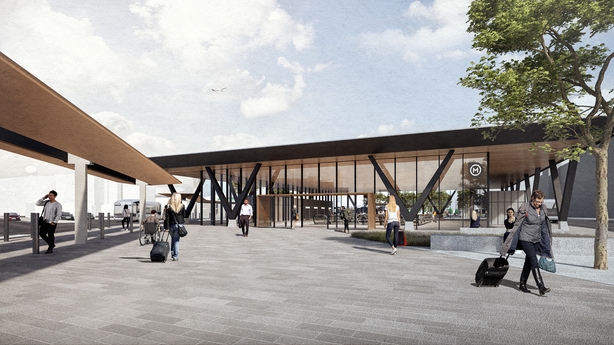A resident in north Dublin whose home has been classified as a protected structure has told An Bord Pleanála inspectors that construction of the Metrolink could damage the property.
The 'White House', located on the Ballymun Road, Dublin 9, was bought by Louise Boughton and Glenn Sharpe in 2019 and was subject to careful restoration in line with protected status buildings.
Ms Boughton told the fourth day of oral hearings into the Metrolink project that the house was designed by acclaimed architect Harold Greenwood and was considered one of the finest examples of art deco design in Dublin.
Transport Infrastructure Ireland (TII) claimed the property was situated some 25 metres away from tunnel line, however Ms Boughton referred to a location plan of the area showing the extent of the substratum land which makes the distance "more like one to two metres".
TII is proposing to build an above ground intervention shaft on the southwest corner of Albert College Park, and the 'White House' property will be the closest residence to the shaft, the oral hearing was told.
The construction of the shaft could damage the single pane windows on the property, which were painstakingly restored and conserved by the owners over a two and a half year period, it was said.
Ms Boughton said she could "not overstate the damage to glazing" due to the construction of the shaft.
"The house is a protected structure for a reason, so let’s protect it," Ms Boughton told An Bord Pleanála.
The oral hearing into the Metrolink project was told that residents believe that Albert College Park was not the best location to construct the intervention shaft for a park of its size and nature.

Albert College Park, on the Ballymun Road in Glasnevin, is sometimes referred to as Hampstead Park.
It has a long and varied history dating back to 1838, when the Glasnevin Institution for Agricultural Teaching was established on the site.
"If the residents are to endure years of intolerable disruption, then they are entitled to have a station," Ms Boughton said.
Ms Boughton called on An Bord Pleanála inspectors to review the route and look at alternative, more suitable locations for the intervention shaft, around north Collins Avenue station.
Ms Boughton said her family were conscious that they were just one property along the route, and they accepted that things have to change.
"The metro is a benefit to society," she added.
She said residents are just trying to save Albert College Park for the thousands of people who enjoy it every day.
In response, TII, the project operators, said its preferred location for a metro station remains at Collins Avenue, in front of Our Lady of Victories Church.
Latest from Metrolink oral hearings
Proposed Metrolink route
TII said this is the best location to attract passengers due to its interchange connectivity options.
If the station was moved to Albert College Park, TII contend that this would attract a lower footfall in terms of passenger numbers.
TII said an intervention shaft was a fire safety requirement, necessary for tunnel ventilation and was needed to get passengers safely out of the tunnel in the event of an emergency.
Earlier this week the hearing was told that that a distance of 762 metres between stations is required to meet fire safety standards.
The hearing was told that a distance of 1km between stations is being applied in the case of Albert College Park, to build the intervention shaft.
TII said this is in line with international best standard practice and National Fire Protection Association (NFPA) guidelines.
TII said the 762m can be subject to a safety assessment, that Dublin Fire Brigade was consulted and it indicated to TII that if it goes to 1km it can still comply with safety standards.
An Bord Pleanála inspectors have asked for clarification in the discrepancy in terms of two distances provided by TII and were told a comprehensive answer will be given on Monday.
TII said other locations were looked at to build the shaft, south of Collins Avenue and north of Griffith Avenue.

However engineers concluded that Albert College Park was the only area along the route between the two stations that meet fire safety requirements.
"We do not want to introduce a shaft in a built-up residential area because it would mean property demolition," TII officials said, adding that they were very constrained about where they could locate it.
TII also said there was a big difference between building an intervention shaft and a station in Albert College Park.
The construction of a station would take more trees out of the park and ultimately have a much greater permanent impact on the park and its amenities, according to TII.
TII said they would also have to alter the alignment of the tunnel.
TII said Ms Boughton’s property would be subject to specific monitoring throughout construction, which would track any movements in the building, including small cracks that may emerge.
Engineers will monitor how the property is behaving and reacting to pressure during construction phase.
A conservation architect will also be consulted throughout construction.







